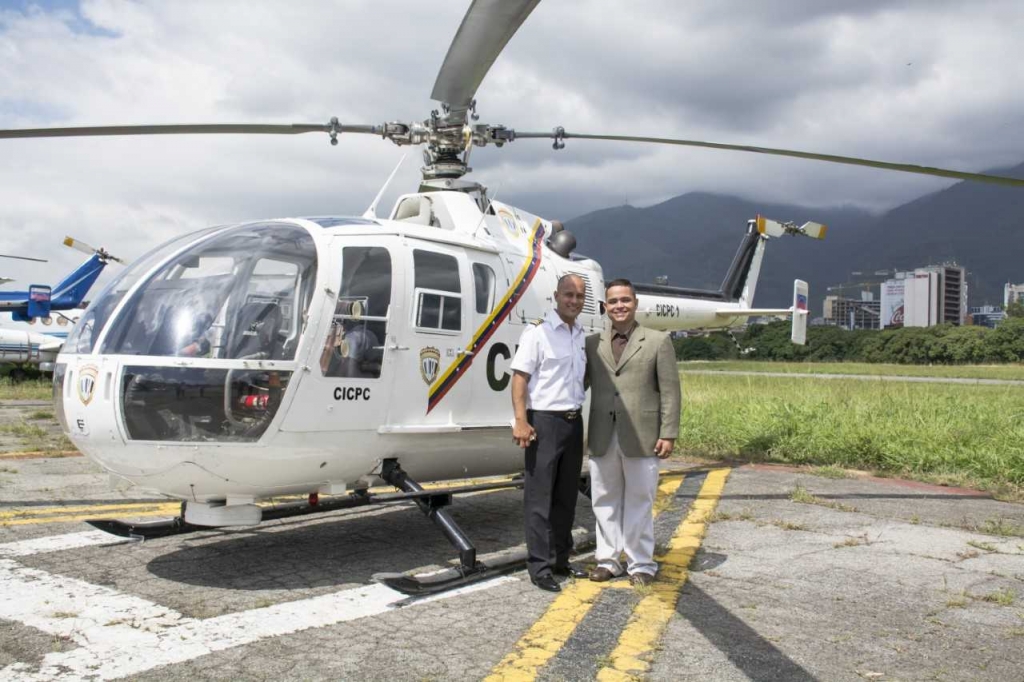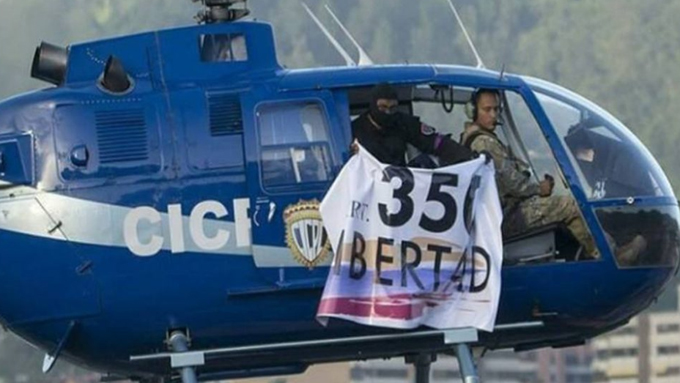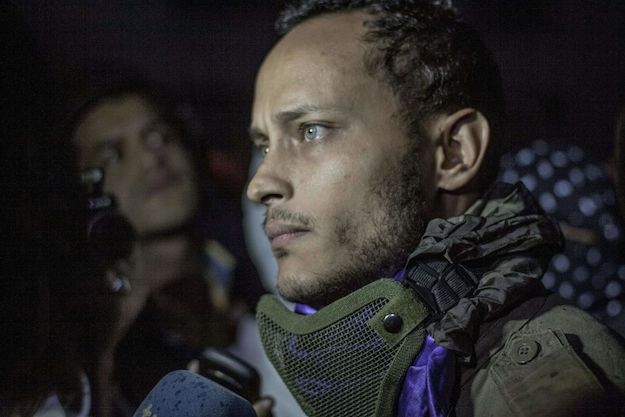When Harold Castro received a call from his friend, Óscar Pérez, to say he was coming over, he grabbed his camera and climbed to the roof of his apartment building.
Castro’s reaction was not unusual. Pérez, a helicopter pilot in Venezuela’s Forensic Police Unit (CICPC), would sometimes swoop low over his photographer friend’s apartment in Caracas before heading out on operations.
But on that day – June 27, 2017 – Pérez’s mission was of an entirely different nature. As he scanned the horizon, looking for his friend’s helicopter, Castro had no idea he would soon be involved in an attempt to topple the government.
Pérez’s armed insurrection, and his death at the hands of Venezuela’s security forces six months later, attracted worldwide media coverage and made him a martyr to opponents of the country’s government. But as he flew towards Castro’s apartment, few Venezuelans had heard of the daredevil pilot and star of an obscure low-budget action film.
Venezuelans were instead trying to survive the country’s economic crisis. The government’s dependence on oil revenues meant that, when the price of crude fell in 2014, it blew a hole in its budget. For ordinary Venezuelans, life became ever more precarious. In 2016 the economy shrank by 16.5 percent. Food shortages meant that a third of the population was eating two or fewer meals per day.
In March 2017 the Supreme Court plunged the country into a political crisis by dissolving the opposition-controlled Congress. Two months later, Nicolás Maduro, the bungling successor to Húgo Chávez, announced plans to replace it with a new constituent assembly, with a vote to elect its members scheduled for July 30, 2017. The news enraged the government’s opponents, who flooded the streets of Caracas. Some wanted the military to depose the president.
Pérez hoped his actions on June 27 would eventually lead to Maduro’s removal. “We wanted there to be a call to the streets that day, there to be big displays, that the people realized there a movement had started,” he would later tell The New York Times.
Castro, an aircraft enthusiast and amateur photographer, had met Pérez in 2014 at La Carlota, a military airbase less than four miles north of his apartment. The pair became friends, bonding over their shared love of aircraft, motorbikes and fast cars. Pérez was 32, a year older than the photographer, with a young family. “We clicked,” said Castro, who had been forced to abandon his own dreams of becoming a pilot when he was diagnosed with diabetes at age 15.
 Pérez, left, and Castro in front of a CICPC helicopter
Pérez, left, and Castro in front of a CICPC helicopter
As the helicopter came into view on June 27, Castro noticed it was flying lower than usual. Pérez was carrying a passenger; Castro assumed it was a member of CICPC’s special forces unit. “I thought to myself, ‘fine, they are going on an operation and want a photo,’” he said.
As the helicopter circled the roof Castro prepared for the shot, using hand signals to guide Pérez away from the sun. The passenger, his face concealed by a balaclava, slid open the helicopter door and revealed a banner. Castro’s heart lurched when he read it: “Art. 350 – Libertad,” or “Article 350 – Freedom”.
An act of sedition
The message was a call to arms. According to Article 350 of Venezuela’s constitution, “the Venezuelan people…will not recognize any regime, legislation or authority that runs counter to democratic values.” The banner’s implication was clear: Maduro’s government was illegitimate.
“It’s hard to say how I stayed calm,” said Castro. “I wanted to shout with emotion, but at the same time I had a responsibility to take the photo. At that moment I understood why he had called me.”
As his neighbors spilled onto the street, cheering and waving flags, Castro shot frame after frame, capturing the moment from various angles. After about four minutes the helicopter turned east, the banner billowing in the breeze. “I waved goodbye to him and he waved at me,” he remembered. “I realized I might not see him again.”
 One of the photos Castro shot of Pérez
One of the photos Castro shot of Pérez
Castro clattered down the stairs from the roof to his apartment, intent on publishing what he had captured. From the 120 photos he had taken, he selected two of the best, posting them to a WhatsApp group he shared with his friends.
Across town residents began hearing explosions and gunfire. Pérez and his passenger had flown from Castro’s apartment complex to the Interior Ministry, firing 15 shots at the building below. They then headed a few hundred yards north-west to the Supreme Court, banked sharply, fired more shots and lobbed at least four stun grenades before disappearing beyond the city’s skyline. No one was injured in the attack. Pérez later claimed the bullets were blanks and the grenades were designed to stun rather than kill.
Amid the chaos a pre-recorded video appeared on Pérez’s Instagram account, posted by one of his supporters. In it, Pérez is flanked by four masked and armed soldiers and stares directly into the camera, wearing combat fatigues with a purple scarf tied to his arm. “We speak to you on behalf of the state. We are a coalition of military, police and civilian officials, in search of balance and against this transitory and criminal government,” he declared solemnly, denouncing the government’s “tyranny” and “impunity” and encouraging Venezuelans to take to the streets.
The video of the telegenic revolutionary spread quickly across social networks. So too did Castro’s shots of the helicopter. “In six minutes the photos went totally viral”, he said.
When news of the attack reached Maduro, the president addressed the nation on television, condemning the “terrorist attack” and vowing to “capture the helicopter and those who have perpetrated this.” Pérez was now the most wanted man in Venezuela.
The “Venezuelan Rambo”
Pérez was no stranger to drama. In 2015 he co-produced and starred in “Muerte Suspendida” (Suspended Death), a film based on the real-life kidnapping of a Venezuelan businessman. Pérez played Efraín Robles, a thinly-veiled version of himself, shooting hostage-takers, scuba diving and skydiving with his pet Belgian Shepherd, Bolkow. The film made him a minor celebrity.
He also made videos to post on Instagram. “He understood the power of social networks,” said Castro. He would often film his friend’s stunts from the helicopter, riding in the passenger seat as Pérez swooped low over the rooftops of Caracas. Both enjoyed James Bond-style exploits: one video showed Pérez shooting a mannequin with a pistol over his own shoulder, using a ladies’ compact mirror to help him aim.
The madcap stunts provided them with an escape from the country’s hardships, but the consequences of the economic crisis were increasingly difficult to ignore. Castro found it almost impossible to source the insulin he needed for his diabetes; his wife struggled to find medication for her asthma. In May, Castro’s father contracted bronchitis. The family couldn’t find the right dosage of the medication he needed, and he died in June. Castro used his camera to document ongoing clashes with the security forces and posted the results on his Instagram account.
Pérez was also struggling. His new-found celebrity made him a target for criminals. In 2016 a gang tried to kidnap one of his children from outside their school, prompting his wife and three children to flee to Mexico for their safety. A year later, days before the helicopter attack, Pérez’s brother was stabbed to death during a robbery. “I had to identify my brother laid out in the morgue on a steel tray completely frozen,” he told the The New York Times.
On the run
As his photo of the helicopter appeared on news websites around the world, Castro began to panic. “I realized that I was in danger…I thought ‘they’re going to realize, they’re going to see that I took the photo and come and look for me.’” He packed his bags. That night a unit from CICPC—Pérez’s former colleagues—raided the building opposite Castro’s.
The following morning, he arrived at Caracas’ international airport and bribed an airline employee to get him on the next flight out of Venezuela. By 7:30 a.m. he was in the air.
The CICPC raided his apartment a few days later, taking computers, printers, monitors, GoPro cameras, even his beloved Yamaha motorcycle. They questioned Castro’s wife for 12 hours, and frightened his 70-year-old mother. “I’m free because I thought more quickly than they did,” he said.
Three days after escaping Venezuela, Castro received a message. It was from Pérez, sent from a safehouse using an encrypted messaging service. He apologized for putting him in danger and explained the purpose of the attack was to distract the government while other military units started an insurrection. But the uprising never came.
The pair exchanged messages sporadically over the next few weeks. “I never asked him for details,” Castro said. “I just wanted to know how he was.”
On July 13, in a brazen act of defiance, Pérez appeared unannounced at a public vigil in Caracas held for protesters killed in anti-government demonstrations. The decision seemed a calculated attempt to inject energy and momentum into the protest movement. He gave a television interview, encouraging Venezuelans to take to the streets in huge numbers. “Maduro, your era is over,” he shouted, before disappearing into the night on the back of a motorbike.
Instead the government tightened its grip on power. On July 30, the election to create the new constituent assembly was held, despite widespread protests.
In the following weeks the anti-government movement lost momentum. Pérez and his supporters disappeared from the news until December, when he and his accomplices raided a National Guard armory, stealing 26 assault rifles and more than 3,000 munitions.
Pérez’s death
In the early hours of January 15, 2018, government forces traced Pérez and six accomplices to a small house in El Junquito, a poor neighborhood 35 minutes outside Caracas’s city center.
What happened next was captured in a series of videos Pérez posted to Instagram. In them, he becomes increasingly anxious as his efforts to surrender to the soldiers surrounding the building are rebuffed. “May God be with us, and may Jesus Christ accompany me,” he said. “Derek, Santiago, Sebastián, I love you with all my heart, sons. I hope to see you again soon.”
Subsequent posts show government forces firing at Pérez and his six comrades. “They don’t want us to hand ourselves in, they literally want to kill us,” he said to the camera, blood streaming from his forehead. In his final post he seems to have given up hope of survival. “Venezuela, we are resisting on behalf of the country. Please go out (onto the streets),” he shouted, scrambling for cover.
Castro woke late that morning to a series of messages from friends. He was distraught as he watched the videos on his mobile phone. “I couldn’t stop crying,” he said. “What I had most feared when I took the photos of the helicopter had come true.”
The following day, Interior Minister Néstor Reverol confirmed the death of Pérez and his six accomplices along with two police officers. He claimed that Pérez had started the shooting. In a speech to troops Maduro celebrated his death. “The Miami-based counterrevolution and the Colombian oligarchy must know that every group they arm and finance to bring terrorism here will be met with the same fate,” he announced.
In exile
Castro does not know whether he will ever be able to return home. Even in exile, he believes Venezuelan agents are pursuing him. “I know I am not completely safe,” he said. “I know that this is not over because anyone related to Óscar Pérez is being persecuted, trapped, tortured.”
He has been charged in absentia with a number of offences, including terrorism and treason. “They say that I was part of (Pérez’s) team, that I’m a terrorist, that I was complicit,” he said, denying any wrongdoing. “There’s nothing illegal about taking a photo.” A guilty verdict could mean 40 years in prison, he said. Nevertheless, he has no regrets about publishing the photos. “I would do it again a thousand times over,” he said.
Although Pérez’s efforts to topple the government failed, Castro insists his friend’s death was not in vain. “All they have are seven bodies,” he explained. “They killed the people, but they did not kill the idea.”
—
Aldwinckle is The Economist’s Argentina and Uruguay correspondent






